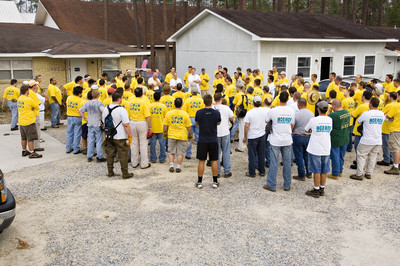Q. What kind of humanitarian work has your church been involved in? Are there statistics or outstanding stories to share?
Excellent question. Thank you for asking it! I can think of very few topics that better assert our “Christian-ness” than humanitarian aid. The Church has been involved in serving others, no matter their religion or nationality, for a long time. Joseph Smith organized the Relief Society for women in order to “provoke the brethren to good works in looking to the wants of the poor.” Brigham Young sent agricultural ambassadors to the Native Americans to improve their crop yields. During and after the first and second World Wars, the Church sent food, medical supplies and clothing to the ravaged nations. (“Doing Good and Being Good.” Harold C. Brown. Women’s Conference, BYU 1997) These kinds of efforts continue today — on an even grander scale.
In 1995, the General Welfare Committee of the Church established an organization known as Latter-day Saint Charities, a non-governmental organization (NGO) like the Red Cross or AfriCare or Catholic Charities. Latter-day Saint Charties has worked all over the world to help people become self-reliant, healthy and take care of basic needs. You can check out their current list of projects here. Click around, you’ll be amazed at how far reaching it is.
I want to point out a couple of notable things here:
- The goal of this organization is to help, yes, but to help with the long-term in mind. They don’t bring in barrels of water, they help the people dig a well. Rather than giving money to unemployed people, they pay for job certification or skill acquisition. “In Guatemala, for example, LDS Charities contracted with an electrician to train and certify more than two dozen Guatemalans in electrical work. All twenty-five or so young men who took the course got jobs” (Brown). The goal is self-sufficiency. That is when aid is really meaningful.
- Every penny donated to LDS Charities goes towards the projects themselves. There is no overhead, no administrative costs or salaries. When you donate to LDS charities, you are directly helping the poor people in the world (not paying electric bills in a high-rise administrative office).
- All of this service is carried out by volunteers. Couple missionaries (the older variety) scout out, set up and see through the projects. Some specialized missionaries – health care professionals, agricultural experts, etc. — are called to serve in their professional capacity for 18 months. This is why there are no salaries involved in the donations. Other volunteers assemble as-needed, as in the case of natural disasters.
 The common anecdote told goes something like this: In the aftermath of a hurricane, a young lady is being interviewed by a TV reporter and he asks her who she has seen getting involved in the cleanup. She responds: “There were two groups here right away–the Mormons and the LDS church.”
The common anecdote told goes something like this: In the aftermath of a hurricane, a young lady is being interviewed by a TV reporter and he asks her who she has seen getting involved in the cleanup. She responds: “There were two groups here right away–the Mormons and the LDS church.”
.
There are thousands of stories, here is just one.